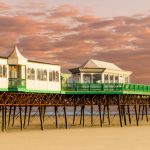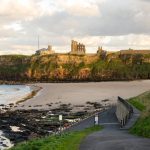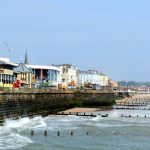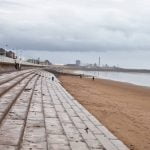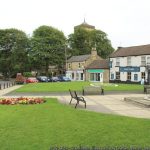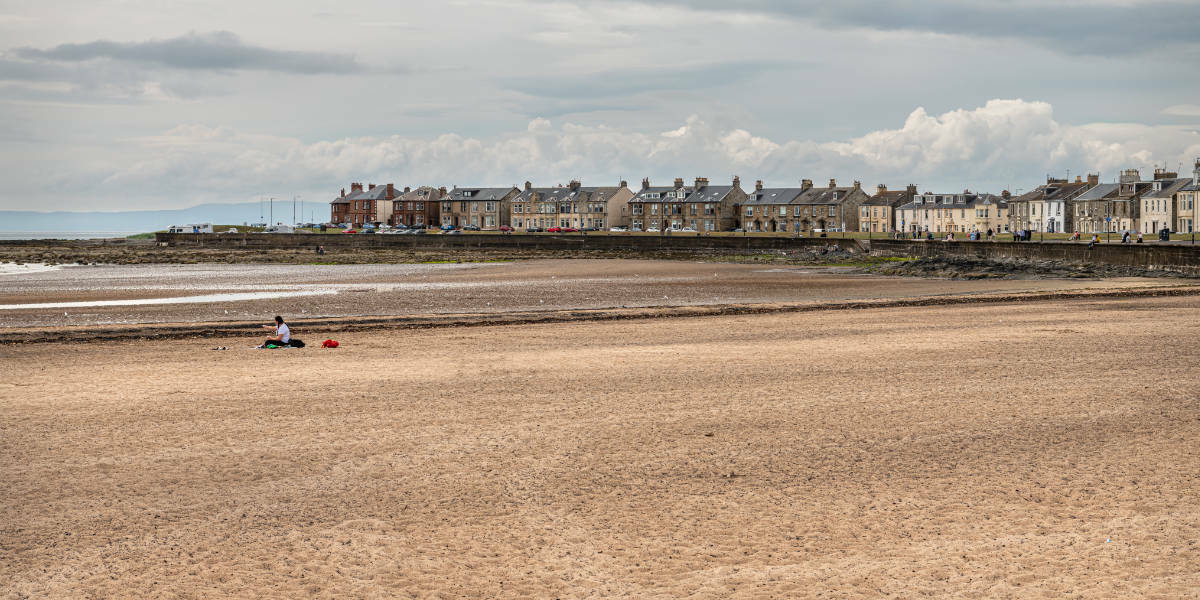
Renowned as a golfing centre, there’s more to Troon than just the tee off.
Troon is a reasonably sized town set on the West Coast of Scotland. Found in rural Ayrshire, Troon is surrounded by stunning sea views, beautiful beaches and of course a golf course the size of East Ayrshire. We wanted to get to the heart of this beautiful staycation destination.
For years now, the people of Scotland have visited the Ayrshire coast summer after summer. We want to know what the attraction is.
Is Troon worth a visit? Let’s take a 5 Minutes Spare tour and find out.
The Early Days of Troon
Troon has a rather interesting name. For whatever reason, the Scots named it after the nose. In Scottish Gaelic, the word is An t-Sròn, which would be shortened over time. The ‘th’ became ‘tr’ and the ‘on’ became ‘oon.’ It was named after a nose though. We know this because the Gaelic speakers named Stranraer, at the opposite end of the same piece of land, the Fat Nose, or An t-Sròn Reamhar.
The Scots probably named the land after a nose because there is a large dip in the coastline below and above Troon. It’s a bit weird, but Scots liked to name things as they saw them.
We know that the land where Troon sits now could have been occupied (if sparsely) as far back as the 12th century. We know this because we know that William Wallace was 27 years old when he visited Ayr in 1297. Ayr lies 8 miles south along the coast from Troon, from whence we have Prestwick and denser population from there to Glasgow in the north. Wallace’s uncle was the Sheriff of Ayr, and his mother lived in Loudon Castle for a time. He came to Ayr for a horrendously dark purpose.
If you have seen Braveheart, you will remember the scene with all the noblemen hanging in the barn. This happened in the countryside surrounding Ayr, leading the incident to be remembered in history as the ‘Barns of Ayr’ . In the same territory as Troon, the English invaders (sorry) summoned all the Scots clan heads to a barn and they bound them, gagged them, and murdered them. When Wallace came here, it was to exact bloody vengeance. He and his men snuck in during the night, while the English soldiers rested in two large barns. They barred the doors and set it on fire.
So yeah, cool place, Troon.
Ayr is so old that it gained the right to hold a market and annual fair in 1261. Traders from the surrounding countryside, including those from the Troon area, would have come to buy and sell. Importantly, any settlement would have been small right up until the 1700s. Fishermen and women would be living all along the coast.
The Fullarton Family
The first reported landowners here were the Fullartons. The Fullarton family lived about a mile from where Troon is now. They owned the land from 1371, when King Robert II granted his old Crosbie Estate to the family as a reward for being supporters. In 1344 the Fullarton family built a castle on the Crosbie estate. It stayed there until the 18th century when it was partially demolished. In the late 1700s, Fullarton House was built, and the remains of the demolished castle were converted into the icehouse. They demolished more of the icehouse in 1969 to make it safe. The castle lies in ruins. Parts of the old icehouse were demolished to make way for the golf course. The castle sat above an underground stream which kept that icehouse perfectly cold.
As well as the Crosby estate, there was also a church and cemetery. The church was first reported in 1229. The structure that lies in ruins on the spot of the old church was built in 1691. Legend says that the roof was blown off in 1759 when Robert Burns was born. One of the graves within the churchyard is dedicated to David Hamilton. Not of the Hamilton clan of the South. This Hamilton was of Bothwellhaugh. He was the alleged assassin of the Regent Moray, who was the bastard son of James the 5th. He died in 1619.
There is a mention of the Fullarton family inheriting the graveyard in the 14th century when the ruins were passed down. Records show the ground was used by a holy order before the Fullartons arrived. This holy order was known as the Gilbertine convent. It was founded in Dalmulin in 1238. In the same year, the Chapel was passed to the monks of Paisley Abbey. Up until 1862, the cemetery remained the burial ground for the people of Troon. The family areas were still being used during World War One. The road between the Fullarton estate and the sea was used by locals who would take carts down to the shore and back again to collect seaweed to use as fertiliser.
The church itself is reported as haunted. An epistle by John Laing says that “ghaists and Spunkies” (ghosts and spooks) used to do dwell in it. Visit it at your own peril.
Let’s take a momentary break from history to talk about the most interesting things to have happened in Troon over the years.
Fun trivia about Troon
This wouldn’t be a 5 Minutes Spare local tour if we didn’t take time to reflect over the best and worst gossip of the area. Here are some of the best things we know about Troon:
- Troon is most famous for the Royal Golf Club. The Royal Troon Club started with just five holes back in 1878. It has grown exponentially since then.
- Every year thousands descend on the small town of Troon for the Royal Golf Open. This Open Championship has residents in nearby towns and villages charging thousands of pounds for three or four nights’ stay in their apartments. This trick has been a moneymaker of Ayr residents for generations.
- People on Aaron called Troon, across the water from them and which they could see on a clear day, An Truthail. In Arran Gaelic, which is a little different again from the Scots, this may have been a corruption of the words for ‘current’. It may be they were describing the land across the current, which is nicer than ‘the nose’.
- You used to be able to sail to Ireland from Troon, but the service stopped in 2016.
- Fullarton House was eventually bought by the town council in 1928. They later demolished it in 1966.
Let’s return to history so that we can get to the best attractions in Troon.
The growth of Troon in the Industrial era
Troon remained a quiet place for 500 years or so. The Duke of Portland was the one who truly built. it, he purchased Fullarton House in 1805. He lived there when he was in Scotland – he was married to an American woman. The 4th Duke of Portland was named William Henry Cavendish-Scott-Bentinck. He recognised that the town made a great area for a port as it jutted out at the edge of the confluence of the Firth of Clyde. He bought the lands off the 12th Earl of Eglington.
From 1808 onwards the Juke developed a natural harbour on the north side of the town. He planned out a revolutionary town, which would use spent ships ballast to form the other side of his port. From 1812 onwards, Troon featured a horse-drawn railway terminus. This connected the Duke of Portland’s coal mines in Kilmarnock to the harbour in Troon. It was not licenced for passengers. Since it was not set up for passenger travel the railroad got around this by weighing people before they got on board and charging them their freight price. We Scots are nothing if not inventive.
During the industrial era, both whetstone and coal were mined in the local region. Troon harbour became an important port for getting that coal into the city of Glasgow and around the rest of Scotland. Most of this expansion was funded by the Duke of Portland and his coal mines.
Although far removed from London, the West Coast of Scotland features many beautiful beaches which have attracted tourists since the Victorian era. We should take into consideration that at the time the Duke of Portland was building up this coal-mining town, it was also gaining Importance as a tourist destination. Sea bathing had become popular among the aristocracy. When the train line arrived, this led to people coming through Troon on the Glasgow-Ayr line. Troon would have made a fine place for a day trip.
Modern Troon
Troon Harbour would be the key area of development that spurred the growth of the town. It was not the coal that made the town famous, but rather that Ballast Bank. This deep harbour allowed shipbuilders to move into Troon. Ships have been built on the Clyde for generations. Troon was part of this long legacy for about 150 years. The fishing fleet from Ayr was moved to Troon Harbour by the Ailsa Shipbuilding Company. They built merchant vessels. P & O moved in. They built a terminal that would operate ferries between Troon and Larne. This service continued up until 2016. The last shipbuilder would leave Troon in the year 2000.
During the Industrial Revolution, Troon’s railway station became one of the first passenger stations in Scotland. The Kilmarnock and Troon railway connected to the coal fields owned by the Duke of Portland and became the first railway line.
Troon Football Club was founded in 1983 to add to the expansive Golf Club which was already in the area. Glasgow Prestwick Airport was built just outside of nearby Prestwick Town in 1962. The first passenger terminal didn’t open until 1964. Elvis Presley passed through here in 1960. Prestwick Airport is only one mile from Troon town centre. The airport and Golf Club both created a thriving leisure industry in town. Troon is filled with hotels, B&Bs and public houses. Modern Troon has all the long stretches of beach that nearby Ayr has, but without the end-to-end sun loungers in summer.
Troon Golf Course was founded in 1878. George Strath was the first golf professional in Troon Golf Club. He helped to plan the layout of the course. It was later extended by James Braid. The first Royal Troon Open was in 1923. The Royal Troon Old Course has attracted golf enthusiasts from around the entire world ever since. The open is highly publicised and attended by all professional golfers of note.
Troon is still a pretty seaside town that doesn’t get quite as much attention as Ayr does. It has a shorter history, but it’s a lovely place to stay if you are hoping to Scotland or are between flights. The one time of year you shouldn’t visit Troon is during the Golf Open. If you are a golfer, then please come along. If you are a holidaymaker, this is when it will be busiest and priciest.
Famous People from Troon
In terms of the age of Scottish towns, Troon is reasonably young. There are still a few famous faces who you might have heard of who come from this area. They include:
- The golfer’s Jimmy Adams and John Black, among many others.
- Footballers David Boyd. John Brown, Tom Brown, Tom Brighton, and David Black.
- Author Duncan Lennon is from here.
- Alan Gemmel from Gardeners Question Time.
- Mark Stoddart, the designer, is from Troon.
OK, so they’re mostly sports personalities. If you like sports, Troon is your place.
The Best Things to See and Do in Troon
What are the best attractions in Troon, we hear you ask? We dug up all the best bits for you to visit.
Historic Sights and Landmarks
The Royal Troon Golf Club is the first and foremost in these parts. Developed all the way back in 1878 and still holding annual competitions, this is one of the most beautiful courses in Scotland. It’s on the windswept regions of the headland, surrounded by scrubland and sands. The clubhouse is spectacular. It has exemplary views out across the sea from the bar area. You pay a bit more for membership than you do at other clubs, but the wide-open course and beauty of the play is worth it, again and again. FYI, you can hit up the Kilmarnock and Barassie golf club if you can’t afford the green fees, or the Darley Golf Club if you need a second alternative.
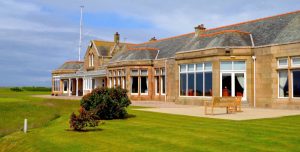
Image: Edinburghcitymom/Shutterstock.com
Visit the old Crosbie Churchyard. You know – the one we told you was haunted. It will put some hairs on your chest, as we Scots say. Don’t go at night and please do remember that people were buried here right up until WWI. There are some important ancient graves here, so please be respectful. The ruins of the old church make an interesting walk.
Galleries and Museums
There aren’t that many galleries in Troon, but you will find local artists in the Framework Gallery. They have a gorgeous collection you can browse through, and you can buy here, too. Oddly enough, there are lots of pictures of the sea.
Troon isn’t either big enough or old enough to have its own museum yet, but there are some nearby. The Scottish Maritime Museum is situated in Irvine, which is just north along the coast. It has lots to offer. People don’t realise that Scotland was the 5th biggest shipbuilder in the world at one time. Up until the 80s, Scotland was big into boats. Most of the country still is since we have depended on the sea for sustenance for so long. The Maritime Museum documents Scotland’s history as a proud seafaring nation.
Outdoor Attractions
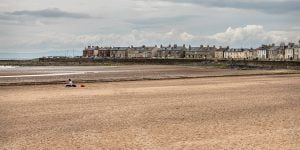
Image: dvlcom/Shutterstock.com
Troon Beach is one of the main attractions in town. Troon has a beautiful stretch of coastline which is mostly sandy. It does tend to kick up a fair amount of seaweed. The beach stretches all the way south through Ayr and past it all the way right down to Dunure, which is about 6 miles south of Ayr. Altogether, the strip of coastline must be 10 to 12 miles long. It stretches north up to Prestwick as well. The beach is busy in summer but not as busy as Ayr.
One of the kid’s favourite things to do in Troon is the Fullarton Fairy Trail. This trail winds its way through woodland, where locals have carved and placed fairy doors in the trees. This is a magical tour that will spark their imagination. Try and find them all but be warned that it gets muddy. It is only 0.6 miles long so it’s accessible for all.
Stop by the Marina in Troon to see how the other half live. There are several sites to see near the harbour. The marina has a yacht haven where the rich keep their boats sheltered from the open sea. There is a huge statue of Britannia wrapped in chains on the seafront, too. This is the town’s war memorial. You can also walk from there to the port and have a gander.
Sports and Recreation
Let’s just ignore the golf clubs because we all know there are loads of them. If you want to play golf on holiday, Troon is the ideal spot. Troon also has its own football club, which is nicknamed the Seasiders. The club isn’t quite as old as the Golf Club here and just celebrated its 25th anniversary.
You should try to walk the old Smuggler’s Trail while you are in town. This trail starts down at the seafront and winds its way along a, particularly coastal path. The views here look out over Arran, and, on a clear day, you can see Ireland in the northwest and the Ailsa Craig to the south. It is a round island that looks like a boob.
Shopping and Retail
Troon has few shopping opportunities, but you should pop into the wee gift shop for presents. Nearby Ayr has plenty of shopping if you need additional things. There are plenty of shops on the high street, most of which sell cosmetics and natural products.
Where to Eat and Drink in Troon?
There are lots of different places to eat and drink in Troon. If you are out for a day trip and enjoy the rarely seen Scottish sun, you can check out the food at the Beach Café or at the Harbour Bar. If you want a sit-down meal, Lido Troon and the Swan Restaurant are a better bet.
Other Notable Attractions
There are other things to see and do in Ayrshire if you have transport. Try to see the following sights if you are staying longer than a few days. Attractions near Troon include:
- Ayr is to the south and has many William Wallace themed attractions. If you wanted to, you could take a trip to the opposite side of Ayr from Troon and visit Alloway, where Robert Burns, Scotland’s treasured poet and creator of Auld Lang Syne, was born.
- Largs is along the coast to the north and has a strong Viking heritage. The annual Viking festival is held here in late August every year.
- Go visit Ayr racecourse and see a race. Wear your fancy hat. Also, they have a car boot/market every Sunday. You can read more about Ayr in our location guide.
How to get to Troon?
If you follow these loose directions, you won’t be far away. Scotland is only a couple of hundred miles wide so you can’t go that far off course.
By Road
Head north out of Ayr, south out of Largs, or west on the A77.
By Rail
Troon railway station has a lovely little café in it. It is on the Glasgow-Ayrshire line.
By Air
Prestwick Airport is one solitary mile away.
By Sea
Aim for the Port of Troon. If you are lucky enough to own a yacht you will be pleased to know there is even a marina.
Got Five Minutes?
Come visit us at Five Minutes Spare and enjoy our travel guides in greater detail. You can pop us a like or follow on Facebook, if you are one of the cool kids.
